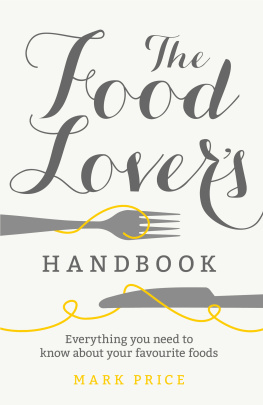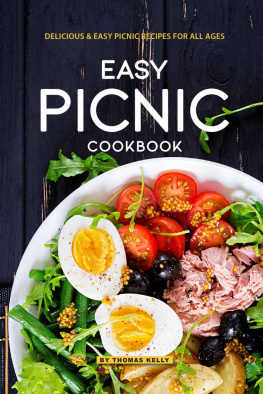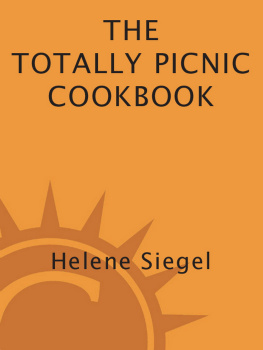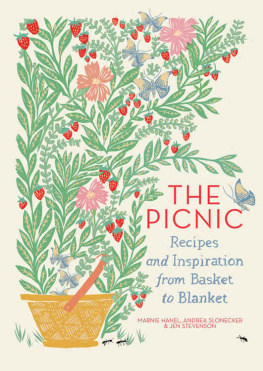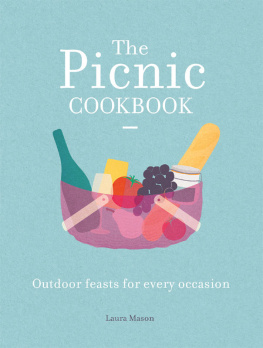C ONTENTS
I NTRODUCTION
PICNICS HAVE BEEN part of my life for as long as I can remember. They were an exciting and glorious part of my childhood. I still remember the frenzy of the morning before an outing, offering to help but only really getting in my mothers way in the kitchen. But my brother and sister (both younger than me) and I would rely on my father to sort out the biscuits, sweets and pop while we squabbled over sandwich fillings before being packed off into the car by my near-exasperated mother.
As we buckled up and began to play I-spy, my parents packed the car with sandwiches and flasks, home-made fruit cake, apples, bananas and hard-boiled eggs, and occasionally chocolate for a real treat. We would then head off to a local beauty spot, garden, historic monument or wood for an adventure and a picnic. We had picnics throughout the year, provided the weather was good, and somehow I never remember us complaining about the cold or the damp we were just so excited to be on an outing.

And while things are very different now for children they have a greater choice of things to do than we did back then I have noticed the same element of excitement whenever the idea of a picnic is mooted at home. For it was these warm and loving childhood memories that inspired my wife, Judith, and I to re-invent the family picnic with our two girls, Holly and Lily, who enjoy them as much as we do. We began taking the girls on picnics when they were at toddler stage, so it has become a family ritual that they want as much as we do. The great thing is that they get as excited as I used to.
Throughout the year, often once or twice a month in the summer, we head off in the car, laden with picnic tables and rugs and a veritable feast to a place we all find fun or stimulating. Indeed, choosing the attraction is half the fun, while the food is just as important as the place. Often we simply take our own, but we also hunt down local suppliers, farm shops, child-friendly cafs and pubs serving locally sourced food. And if we dont eat out, we often find goodies to bring home for supper. Picnics have become very much part of our family life and are occasions I love sharing with friends too, which is why I wanted to create this book as a celebration of the outdoor feast.
I have selected some of our favourite places from all over the country the beautiful, the unusual, the historic and the quirky. These are some of the places we go back to time and time again. The wonderful thing about this country is that there are so many beautiful locations parklands, woods, coastal areas, magnificent gardens and great houses that we can all enjoy. And I think we are particularly lucky to have an organisation such as the National Trust which manages and looks after them so well. This is why I want to play my own small part and donate all my proceeds from this book to the National Trust to help it continue with this great work.
And while I have only listed some of our favourite places, I am sure each reader will have his or her own special picnic spot. Id like to invite you to share your thoughts and ideas with us, which I can then post on the Chubby Grocer website, so that eventually we will be able to list all the best picnic spots in the UK. Please send your favourites to www.chubbygrocerpicnics.co.uk
The Picnic
A P OTTED H ISTORY
HOW DID THE picnic evolve? Was the very first one, where we ate for pleasure in the outdoors, in the Garden of Eden? Once wed lost our innocence and were cast out from paradise, eating outside somehow lost its gloss. It seemed that any mention of eating in the open air was for travellers or workers only. Soldiers took rations on their long marches, shepherds took provisions into the mountains, travellers took what they could carry and supplemented their needs en route. The rest of our ancestors remained resolutely indoors.
Indeed, nobody is quite sure when the picnic became the pleasure it is now. In fact, nobody is quite sure where the word came from either. Was it from potluck a gathering to which each person attending contributed a dish for all to share? Or was it from the French piquer to pick, and its rhyming compatriot nique a thing of little importance. Id hate to think the French got there first!
Throughout history and literature there are descriptions and illustrations of grand feasts the dinners at Villa Lante, with its special table along which running water flowed for guests to wash fingers or fruits, the midsummer banquets of Elizabethan England, the glittering garden parties at Versailles. But these were all the prerogative of the rich and noble the poor might wait at the gate for scraps! And it continued in this vein with the great hunt breakfasts and shooting party lunches of Edwardian England.
However, two events at the end of the 18th century in France and the early 19th century in Britain began to change things. In France after the Revolution, the Royal Parks were opened to the public for the first time and became extremely popular meeting places for the newly enfranchised citizens of the Republic, who used them both to rest and play. And gradually food became an integral part of the hours spent within them.
In Britain, another revolution, the Industrial Revolution, brought people in their thousands to the new centres of industry dusty, smoky towns and cities. The workers longed for the clean air and space they had left behind, and so began to plan days out when they could get away from the city to a park, a field, a coastline. From there evolved the picnic we all know and enjoy today whether its at the school sports day, on a perfect beach on a sunny summers day, at a wild and windy point-to-point or an ultra-glamorous event at Royal Ascots No. One Car Park. Be it on the expansive lawns at Glyndebourne or sheltering from the rain in the wilds of Dartmoor, picnics evoke tastes and memories for all of us.
About the Book
Packing up a picnic hamper, throwing a rug in the car boot and savouring an outdoor feast is a time-honoured tradition that never fails to excite and delight. For adults the word picnic evokes warm childhood memories and the enjoyment of simple pleasures, and for children its suggestion of fun and treats brightens up the dullest of days.
In this beautifully illustrated book, passionate picnicker Mark Price celebrates, and offers inspiration for, this great British institution in all its guises. He provides seasonal recipes for all manner of drinks and picnic fare from quick and easy sandwiches and soups, to more elaborate pies and cakes whatever the time of year, whatever the weather and however much time you have to prepare. He also offers:
Next page

